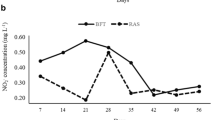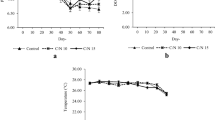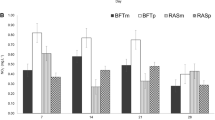Abstract
Biofloc technology (BFT) is gaining popularity in the aquaculture sector. In this study, the effects of different carbon-to-nitrogen (C:N) ratios in jaggery-supplemented BFT systems on water quality, microbial diversities, feed performance, and growth, welfare, and proximate composition of Nile tilapia (Oreochromis niloticus) were investigated. The study had a completely randomized design (312.5 g/m3 in water tanks containing 4000 L water) and was carried out in triplicate, with a control group without biofloc and three groups of BFT-treated Nile tilapia (0.50 ± 0.05 g) reared in different C:N ratios, i.e., 15:1 (CN15), 20:1 (CN20), and 25:1 (CN25), for 120 days. The fish were fed a commercial diet at 2–5% of their body weight daily. The BFT performed significantly (P < 0.05) better in all measured aspects. Lower dissolved oxygen, pH, ammonia, abundance of beneficial microbes like Firmicutes and Actinobacteria, higher floc volume, and total heterotrophic counts were observed with increasing C:N ratios. The highest survivability, highest body weight, lowest feed conversion ratio, and better stress and liver biomarkers, hematology, innate immunity and antioxidant properties were recorded in the BFT system with the lower C:N ratios. The best histological status of the liver and intestines was found in fish cultured in the CN15 group, followed by fish cultured in the CN20 and CN25 groups. Considering all aspects, the C:N ratio of 15:1 was the most suitable for the biofloc culture of Oreochromis niloticus.



Similar content being viewed by others
References
Ahmad HI, Verma AK, Rani AB, Rathore G, Saharan N, Gora AH (2016) Growth, non-specific immunity and disease resistance of Labeo rohita against Aeromonas hydrophila in biofloc systems using different carbon sources. Aquaculture 457:61–67
Ahmad I, Babitha Rani AM, Verma AK, Maqsood M (2017) Biofloc technology: an emerging avenue in aquatic animal healthcare and nutrition. Aquac Int 25:1215–1226
Al-Habori M, Al-Aghbari A, Al-Mamary M, Baker M (2002) Toxicological evaluation of Catha edulis leaves: a long term feeding experiment in animals. J Ethnopharmacol 83:209–217
Aly SM, Taha RM, El-Bhar SM (2009) The effect of stocking density on some biochemical parameters of Oreochromis niloticus reared in different stocking densities. Suez Canal Vet Med JVX 1:101–110
Anderson DP, Siwicki AK (1995) Basic haematology and serology for fish health programs. In: Shariff M, Auther JR, Subasinghe RP (eds) Diseases in Asian Aquaculture II. Fish Health Section. Asian Fisheries Society, Manila, pp 185–202
AOAC (2012) Official methods of analysis. 19th edition. Association of Official Analytical Chemists, Arlington
APHA (2005) Standard methods for the examination of water and wastewater. 21st edn. American Public Health Association/American Water Works Association/Water Environment Federation, Washington DC
Ashford CA (1943) Acid haematin method for haemoglobin estimation. British Med J 2:575–577
Avnimelech Y (2006) Bio-filters: the need for a new comprehensive approach. Aquac Eng 34:172–178
Avnimelech Y (2009) Biofloc technology. A practical guidebook. The World Aquaculture Society, Baton Rouge
Azim ME, Little DC (2008) The biofloc technology (BFT) in indoor tanks: water quality, biofloc composition, and growth and welfare of Nile tilapia (Oreochromis niloticus). Aquaculture 283:29–35
Bakhshi F, Najdegerami EH, Manaffar R, Tokmechi A, Farah KR, Jalali AS (2018) Growth performance, haematology, antioxidant status, immune response and histology of common carp (Cyprinus carpio L.) fed biofloc grown on different carbon sources. Aquac Res 49:393–403
Beers RF Jr, Sizer IW (1952) A spectrophotometric method for measuring the breakdown of hydrogen peroxide by catalase. J Biol Chem 195:133–140
Bowker JD, Carty D, Bowman MP (2013) The safety of SLICE (0.2% Emamectin Benzoate) administered in feed to fingerling rainbow trout. North Am J Aquac 75:455–462
Crab R, Avnimelech Y, Defoirdt T, Bossier P, Verstraete W (2007) Nitrogen removal techniques in aquaculture for sustainable production. Aquaculture 270:1–14
Crab R, Chielens B, Wille M, Bossier P, Verstraete W (2010) The effect of different carbon sources on the nutritional value of bioflocs, a feed for Macrobrachium rosenbergii post larvae. Aquac Res 41:559–567
Das S, Ward LR, Burke C (2008) Prospects of using marine actinobacteria as probiotics in aquaculture. Appl Microbiol Biotechnol 81:419–429
Dauda AB, Romano N, Ebrahimi M, Teh JC, Ajadi A, Chong CM, Karim M, Natrah I, Kamarudin MS (2018) Influence of carbon/nitrogen ratios on biofloc production and biochemical composition and subsequent effects on the growth, physiological status and disease resistance of African catfish (Clarias gariepinus) cultured in glycerol-based biofloc systems. Aquaculture 483:120–130
Department of Fisheries Ministry of Fisheries, Animal Husbandry and Dairying (2020) Handbook on fisheries statistics. Government of India, New Delhi
Dilmi A, Refes W, Meknachi A (2022) Effects of C/N Ratio on Water Quality, Growth Performance, Digestive Enzyme Activity and Antioxidant Status of Nile tilapia Oreochromis niloticus (Linnaeus, 1758) in Biofloc Based Culture System. Turkish J Fish Aquat Sci. https://doi.org/10.4194/trjfas19754
Durigon EG, Lazzari R, Uczay J, Lopes DLDA, Jerônimo GT, Sgnaulin T, Emerenciano MGC (2020) Biofloc technology (BFT): adjusting the levels of digestible protein and digestible energy in diets of Nile tilapia juveniles rose in brackish water. Aquac 5:42–51
Elayaraja S, Mabrok M, Algammal A, Sabitha E, Rajeswari MV, Zagorsek K, Ye Z, Zhu S, Rodkhum C (2020) Potential influence of jaggery-based biofloc technology at different C:N ratios on water quality, growth performance, innate immunity, immune-related genes expression profiles, and disease resistance against Aeromonas hydrophila in Nile tilapia (Oreochromis niloticus). Fish Shellfish Immunol 107:118–128
FAO (2016) FAO yearbook 2014. Fishery and aquaculture statistics. Food and Agriculture Organization of the United Nations, Rome
FAO (2022) Fish Stat J: universal software for fishery statistical time series: aquaculture production 1950–2020. Food and Agriculture Organization of the United Nations, Rome
Gao F, Katz LA, Song W (2012) Insights into the phylogenetic and taxonomy of philasterid ciliates (Protozoa, Ciliophora, Scuticociliatia) based on analyses of multiple molecular markers. Mol Phylogenet Evol 64:308–317
Girón-Perez MI, Montes-Lopez M, Garcia-Ramirez LA, Romero-Banuelos CA, Robledo-Marenco ML (2008) Effect of sub-lethal concentrations of endosulfan on phagocytic and hematological parameters in Nile tilapia (Oreochromis niloticus). Bull Environ Contam Toxicol 80:266–269
GlobalNewswire (2021) https://www.globenewswire.com/news-release/2021/05/17/2230430/28124/en/Global-Tilapia-Market-Report-2021-202-with-Company-Analysis-of-Seatrade-Atlantic-Capes-Fisheries-Inc-Atalanta-Corporation-Ideal-Foods-Ltd-Sea-Delights.html. Accessed 17 May 2021
Handayani KS, Irawan B, Soegianto A (2020) Short-term mercury exposure in tilapia (Oreochromis niloticus) at different salinities: impact on serum osmoregulation, hematological parameters, and Na+/K+-ATPase level. Heliyon. https://doi.org/10.1016/j.heliyon.2020.e04404
Hargreaves JA (2006) Photosynthetic suspended-growth systems in aquaculture. Aquac Eng 34:344–363
Haridas H, Verma AK, Rathore G, Prakash C, Sawant PB, Rani AMB (2017) Enhanced growth and immuno–physiological response of genetically improved farmed tilapia in indoor biofloc units at different stocking densities. Aquac Res 48:4346–4355
Ismail M, Wahdan A, Yusuf MS, Metwally E, Mabrok M (2019) Effect of dietary supplementation with a synbiotic (Lacto Forte) on growth performance, haematological and histological profiles, the innate immune response and resistance to bacterial disease in Oreochromis niloticus. Aquac Res 50:2545–2562
Jauncey K (2000) Nutritional requirements. Tilapias: biology and exploitation. Berlin, Springer
Kamilya D, Debbarma M, Pal P, Kheti B, Sarkar S, Singh ST (2017) Biofloc technology application in indoor culture of Labeo rohita (Hamilton, 1822) fingerlings: the effects on inorganic nitrogen control, growth and immunity. Chemosphere 182:8–14
Khanjani MH, Sharifinia M (2021) Production of Nile tilapia Oreochromis niloticus reared in a limited water exchange system: the effect of different light levels. Aquaculture 542:736912. https://doi.org/10.1016/j.aquaculture.2021.736912
Khanjani MH, Sajjadi MM, Alizadeh M, Sourinejad I (2017) Nursery performance of Pacific white shrimp (Litopenaeus vannamei Boone, 1931) cultivated in a biofloc system: the effect of adding different carbon sources. Aquac Res 48:1491–1501
Laiz-Carrion R, Viana IR, Cejas JR, Ruizjarabo I, Jerez S, Martos JA, Mancera JM (2012) Influence of food deprivation and high stocking density on energetic metabolism and stress response in red porgy, Pagrus pagrus L. Aquac Int 20:585–599
Lim C, Yildirim-Aksoy M, Li MH, Welker TL, Klesius PH (2009) Influence of dietary levels of lipid and vitamin E on growth and resistance of Nile tilapia to Streptococcus iniae challenge. Aquaculture 298:76–82
Lima-junior SE, Cardone IB, Goitein R (2002) Determination of a method for calculation of allometric condition factor of fish. Acta Sci 24:397–400
Liu G, Ye Z, Liu D, Zhao J, Sivaramasamy E, Deng Y, Zhu S (2018a) Influence of stocking density on growth, digestive enzyme activities, immune responses, antioxidant of Oreochromis niloticus fingerlings in biofloc systems. Fish Shellfish Immunol 81:416–422
Liu G, Zhu S, Liu D, Ye Z (2018b) Effect of the C/N ratio on inorganic nitrogen control and the growth and physiological parameters of tilapias fingerlings, Oreochromis niloticu reared in biofloc systems. Aquac Res 49:2429–2439
Lone GN, Shammi QJ, Mir SA, Sheikh IA, Chalkoo SR (2012) Rainbow trout hematology coinciding with metabolic requirement. Walailak J Sci Tech 9:309–316
Long L, Yang J, Li Y, Guan C, Wu F (2015) Effect of biofloc technology on growth, digestive enzyme activity, hematology, and immune response of genetically improved farmed tilapia (Oreochromis niloticus). Aquaculture 448:135–141
Mali P, Ghosh S, Dash G, Abraham TJ, Chowdhury S, Das SK (2021) A study on ground reality of freshwater fish farming in biofloc tank in West Bengal, India. J Inland Fish Soc India 53:132–142
Martinez-Alvarez RM, Morales AE, Sanz A (2005) Antioxidant defences in fish: biotic and abiotic factors. Rev Fish Biol Fish 15:75–88
Meenakshisundaram M, Sugantham F, Muthukumar C, Gopalakannan A, Panigrahi A (2019) Effect of in-situ and ex-situ biofloc on immune response of genetically improved farmed tilapia. Fish Shellfish Immunol 92:698–705
Meenakshisundaram M, Sugantham F, Muthukumar C, Chandrasekar MS (2021) Metagenomic characterization of biofloc in the grow-out culture of genetically improved farmed tilapia (GIFT). Aquac Res 52:4249–4262
Minabi K, Sourinejad I, Alizadeh M, Ghatrami ER, Khanjani MH (2020) Effects of different carbon to nitrogen ratios in the biofloc system on water quality, growth, and body composition of common carp (Cyprinus carpio L.) fingerlings. Aquac Int 28:1883–1898
Mirzakhani N, Ebrahimi E, Jalali SAH, Ekasari J (2019) Growth performance, intestinal morphology and nonspecific immunity response of Nile tilapia (Oreochromis niloticus) fry cultured in biofloc systems with different carbon sources and input C: N ratios. Aquaculture 512:734235. https://doi.org/10.1016/j.aquaculture.2019.734235
Misra HP, Fridovich I (1972) The role of superoxide anion in the autoxidation of epinephrine and a simple assay for superoxide dismutase. J Biol Chem 247:3170–3175
Mutlu E, Aydın S, Kutlu B (2015) Alterations of growth performance and blood chemistry in Nile tilapia (Oreochromis niloticus) affected by copper sulfate in long-term exposure. Turk J Fish Aquatic Sc 15:481–488
Myers MS, Rhodes LD, Mc Cain BB (1987) Pathologic anatomy and pattern of occurrence of hepatic neoplasm, putative preneoplastic lesions and other idiopathic hepatic conditions in English sole (Parophrys vetulus) from Puget Sound Washington. J Natl Cancer Inst 78:333–363
Najdegerami EH, Bakhshi F, Lakani FB (2016) Effects of biofloc on growth performance, digestive enzyme activities and liver histology of common carp (Cyprinus carpio L.) fingerlings in zero-water exchange system. Fish Physiol Biochem 42:457–465
Naylor RL, Hardy RW, Buschmann AH, Bush SR, Cao L, Klinger DH, Little DC, Lubchenco J, Shumway SE, Troell M (2021) A 20-year retrospective review of global aquaculture. Nature 591:551–563
Norman-López A, Bjørndal T (2009) Is tilapia the same product worldwide or are markets segmented? Aquac Econ Manag 13:138–154
Pacheco M, Santos MA (2002) Biotransformation, genotoxic and histopathological effects of environmental contaminants in European eel (Anguilla anguilla L.). Ecotoxicol Environ Saf 53:331–347
Panigrahi A, Sundaram M, Chakrapani S, Rajasekar S, Dayal JS, Chavali G (2017) Effect of carbon and nitrogen ratio (C:N) manipulation on the production performance and immunity of Pacific white shrimp Litopenaeus vannamei (Boone, 1931) in a biofloc based rearing system. Aquac Res 50:29–41
Parry RM, Chandan RC, Shahani KM (1965) A rapid and sensitive assay of muramidase. Proc Soc Exp Biol Med 119:384–386
Pérez-Fuentes JA, Pérez-Rostro CI, Hernández-Vergara MP, Monroy-Dosta MC (2018) Variation of the bacterial composition of biofloc and the intestine of Nile tilapia Oreochromis niloticus, cultivated using biofloc technology, supplied different feed rations. Aquac Res 49:3658–3668
Quade MJ, Roth JA (1997) A rapid, direct assay to measure degranulation of bovine neutrophil primary granules. Vet Immunol Immunopathol 58:239–248
Rao RSV, Raju MVLN, Reddy MRS, Pavani P (2006) Interaction between dietary calcium and non-phytate phosphorus levels on growth, bone mineralization and mineral excretion in commercial broilers. Anim Feed Sci Technol 131:135–150
Raskovic BS, Stankovic MB, Markovic ZZ, Poleksic VD (2011) Histological methods in the assessment of different feed effects on liver and intestine of fish. J Agric Sci Belgrade 56:87–100
Roberts R J (2012) Fish pathology. 4th edition. Wiley-Blackwell, Hoboken, pp 383–401
Schryver PD, Sinha AK, Kunwar PS, Baruah K, Verstraete W, Boon N, Boeck GD, Bossier P (2010) Poly-beta-hydroxybutyrate (PHB) increases growth performance and intestinal bacterial range-weighted richness in juvenile European sea bass, Dicentrarchus labrax. Appl Microbiol Biotechnol 86:1535–1541
Shourbela RM, Khatab SA, Hassan MM, Doan HV, Dawood MAO (2021) The effect of stocking density and carbon sources on the oxidative status and nonspecific immunity of Nile tilapia (Oreochromis niloticus) reared under Biofloc conditions. Animals. https://doi.org/10.3390/ani11010184
Siddiqui AQ, Howlader MS, Adams AA (1988) Effect of dietary protein level on growth, feed conversion and protein utilization in fry and young tilapia, Oreochromis niloticus. Aquaculture 70:63–73
Silva MRD, Natali MRM, Hahn NS (2012) Histology of the digestive tract of Satanoperca pappaterra (Osteichthyes, Cichlidae). Acta Sci Biol Sci 34:319–326
Sivanandhan S, Khusro A, Paulraj MG, Ignacimuthu S, Al-Dhabi NA (2017) Biocontrol properties of Basidiomycetes: an overview. J Fungi (Basel). https://doi.org/10.3390/jof3010002
Smith BJ, Smith SA, Tengjaroenkul B, Lawrence TA (2000) Gross morphology and topography of the adult intestinal tract of the tilapian fish, Oreochromis niloticus L. Cells Tissues Organs 166:294–303
Srivastav AK, Agarwal K, Kumar A, Prasad MR, Srivastav SK, Suzuki N (2021) Effect of chromium chloride on serum calcium and phosphate levels of stinging catfish Heteropneustes fossilis. Int Aquatic Res 13:81–87
Taddese F, Huh MD, Bai SC, Vijverberg J (2014) Histological changes of liver in overfed young Nile tilapia. J Fish Aquatic Sci 9:63–74
Tan BL, Norhaizan ME, Liew WPP, Rahman HS (2018) Antioxidant and oxidative stress: a mutual interplay in age-related diseases. Front Pharmacol. https://doi.org/10.3389/fphar.2018.01162
Wagner M, Rath G, Amann R, Koops HP, Schleifer KH (1995) In situ identification of ammonia-oxidizing bacteria. Syst Appl Microbiol 18:251–264
Walkley AJ, Black IA (1934) Estimation of soil organic carbon by the chromic acid titration method. Soil Sci 37:29–38
Wang G, Yu E, Xie J, Yu D, Li Z, Luo W, Qio L, Zheng Z (2015) Effect of C/N ratio on water quality in zero-water exchange tanks and the biofloc supplementation in feed on the growth performance of crucian carp, Carassius auratus. Aquaculture 443:98–104
Wei Y, Liao SA, Wang AL (2016) The effect of different carbon sources on the nutritional composition, microbial community and structure of bioflocs. Aquaculture 465:88–93
Widanarni EJ, Maryam S (2012) Evaluation of Biofloc technology application on water quality and production performance of Red tilapia Oreochromis sp. cultured at different stocking densities. Hayati J Biosci 19:73–80
Xu WJ, Pan LQ (2012) Effects of bioflocs on growth performance, digestive enzyme activity and body composition of juvenile Litopenaeus vannamei in zero-water exchange tanks manipulating C/N ratio in feed. Aquaculture 356–357:147–152
Xu WJ, Pan LQ (2014) Evaluation of dietary protein level on selected parameters of immune and antioxidant systems, and growth performance of juvenile Litopenaeus vannamei reared in zero-water exchange biofloc-based culture tanks. Aquaculture 426:181–188
Xu W, Wen G, Su H, Xu Y, Hu X, Cao Y (2022) Effect of input C/N ratio on bacterial community of water biofloc and shrimp gut in a commercial zero-exchange system with intensive production of Penaeus vannamei. Microorganisms. https://doi.org/10.3390/microorganisms10051060
Zhang Z, Deng Q, Cao X, Zhou Y, Song C (2021) Patterns of sediment fungal community dependent on farming practices in aquaculture ponds. Front Microbiol. https://doi.org/10.3389/fmicb.2021.542064
Zhao Z, Xu Q, Luo L, Wang C, Li J, Wang L (2014) Effect of feed C/N ratio promoted bioflocs on water quality and production performance of bottom and filter feeder carp in minimum-water exchanged pond polyculture system. Aquaculture 434:442–448
Acknowledgements
The authors are grateful to the Vice-Chancellor, West Bengal University of Animal and Fishery Sciences, Kolkata, and the Head of Sasya Shyamala Krishi Vigyan Kendra, Sonarpur, Kolkata, for providing the necessary facilities for the experiments.
Author information
Authors and Affiliations
Corresponding author
Ethics declarations
Conflict of Interest
The authors declare that they have no conflict of interest.
Additional information
Publisher's Note
Springer Nature remains neutral with regard to jurisdictional claims in published maps and institutional affiliations.
Rights and permissions
Springer Nature or its licensor (e.g. a society or other partner) holds exclusive rights to this article under a publishing agreement with the author(s) or other rightsholder(s); author self-archiving of the accepted manuscript version of this article is solely governed by the terms of such publishing agreement and applicable law.
About this article
Cite this article
Mali, P., Ghosh, S., Dash, G. et al. Effects of different carbon-to-nitrogen ratios on Nile Tilapia Oreochromis niloticus in the biofloc rearing system. Fish Sci 90, 239–256 (2024). https://doi.org/10.1007/s12562-023-01740-3
Received:
Accepted:
Published:
Issue Date:
DOI: https://doi.org/10.1007/s12562-023-01740-3




